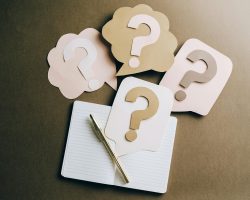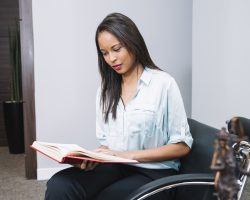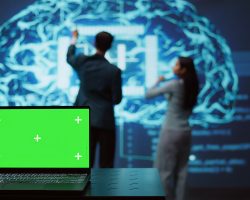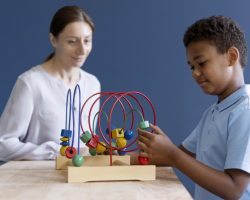What Is Nonverbal Learning Disorder?
October 8, 2024

Nonverbal learning disorder is a little-known condition that impacts more people than you might imagine, causing real daily difficulties for the adults and children who have it. Learn the signs of this confusing condition, and what you can do to treat it.
What is Nonverbal Learning Disorder (NLD or NVLD)?
Nonverbal learning disorder (NLD or NVLD), otherwise known as nonverbal learning disability, may be the most overlooked, misunderstood, and under-diagnosed learning disability. The brain-based condition is characterized by poor visual, spatial, and organizational skills; difficulty recognizing and processing nonverbal cues; and poor motor performance.
The name “non-verbal learning disorder” is confusing; it suggests that those with NLD do not speak, but quite the opposite is true. Approximately 93 percent of communication is non-verbal — body language, facial expressions, tone of voice. Those with NLD have trouble interpreting this non-verbal language, relying on the seven percent of communication that is verbal to understand what others mean.
Because individuals with NLD rely so much on verbal expression, given their difficulties with body language, facial expressions, tone of voice and other cues, they often talk excessively to compensate for their difficulties — a child or adult with NLD will hold you to every word you say. Most children with NLD, as a result, also have large vocabularies and outstanding memory and auditory retention.
How Common in Nonverbal Learning Disorder?
Once considered highly rare, NLD may also be as prevalent as dyslexia — though the high incidence of missed diagnoses makes it difficult to estimate its true impact. We do know that NLD affects girls just as frequently as it does boys, and tends to run in families, like most other learning disabilities.
NLD and anxiety tend go hand in hand, because of the inability to understand and connect with parents, teachers, peers, and spouses. Young children with NLD are usually good at hiding or compensating for their challenges — and often charm adults with their precocious conversation skills. But once puberty hits, NLD can cause serious trouble — teenagers with the condition often develop extreme anxiety over their inability to connect with their peers; trouble setting priorities or picking up social cues may cause an adult with NLD to lose jobs or jeopardize relationships. Many students become school-phobic, and adults with NLD have trouble communicating with coworkers and the boss.
[Take This Test: Nonverbal Learning Disorder (NLD) in Adults]
[Take This Test: Nonverbal Learning Disorder (NLD) in Children]
What Are the Symptoms of Nonverbal Learning Disorder?
NLD varies from person to person, and is not defined as a separate condition in the Diagnostic and Statistical Manual of Mental Disorders, Volume 5 (DSM-V). However, commonly reported symptoms include the following:
- Trouble recognizing nonverbal cues (facial expressions, body language)
- Early speech and language acquisition (talks “like an adult” from a young age)
- Poor coordination; seen as “clumsy” or always “getting in the way”
- Poor fine motor skills (difficulty using scissors, tying shoes, etc.)
- Always asking questions, to the point of being repetitive or interrupting the regular flow of conversation
- Needs to verbally “label” information in order to understand it; difficulty comprehending unsaid or spatial information
- Visual-spatial difficulties (discrimination of differences of objects, visualization of images, determining one’s location of body in space)
- Extremely “literal;” struggles with sarcasm, innuendo, or other linguistic nuances
- “Naïve” or overly-trusting
- Difficulty coping with change
- Trouble following multi-step directions
- Difficulty making generalizations or seeing the “big picture”
- Overall challenges often masked by highly advanced verbal skills
Another telltale sign: Despite their verbal proficiency, those with NLD — particularly children — often exhibit poor reading comprehension. “A child with NLD may miss the forest and the trees because of his intense focus on the leaves,” says Priscilla Scherer, R.N. “After reading a book about the Civil War, for instance, the child might be able to name and describe each battlefield — yet fail to recognize that the conflict was about slavery and federalism.”
ADHD and NLD or NVLD
NLD is often misdiagnosed or confused for ADHD, due to shared symptoms like social skills difficulties, anxiousness, disorganization, and more. While ADHD and NLD are both brain-based conditions, each has different causes, and the appropriate interventions for the two conditions are not the same.
[Read This: Why Nonverbal Learning Disorder Is So Often Mistaken for ADHD]
“Virtually every child I’ve seen with NLD was first diagnosed with ADHD,” said the late Marcia Rubinstien, an education specialist in West Hartford, Connecticut, and founder of the Nonverbal Learning Disability Association. “Pediatricians ought to be able to recognize NLD and refer children for an evaluation, but teachers and medical professionals are more aware of language-based learning disabilities.”
Diagnosing Nonverbal Learning Disorder
A mental health professional specializing in the condition and familiar with similar disorders, like a neuropsychologist, is the best person to evaluate and diagnose signs of NLD in you or your child. He or she will evaluate a patient’s speech and language development, verbal IQ, performance IQ, visual-spatial skills, and motor development. A patient’s score on any one of these individual tests doesn’t matter much, in and of itself; rather, the specialist will be looking to see whether the patient’s overall strengths and weaknesses match the most common patterns seen in patients with NLD.
If a clinician mistakes NLD for ADHD, the patient will likely be placed on ADHD medication, which does nothing for NLD symptoms and may even exacerbate them or lead to other complications. That’s why getting the right diagnosis and receiving early intervention is imperative.
Treatment Options for Nonverbal Learning Disorder
There is no standard treatment approach for NLD, since so little is known about the condition. As with ADHD, education about NLD is key for all who work with your child. Social-emotional learning (reading body language, tone of voice, protocols), executive function training (to develop deficient processing skills), and physical therapy can help children manage NLD symptoms.
Unlike other learning disabilities, NLD isn’t covered under IDEA. So, even with a formal diagnosis, your child may not qualify for an IEP or 504 Plan from her school unless she has another diagnosis or disability. This doesn’t mean your child is ineligible for extra help, however. Useful formal or informal accommodations include social skills groups, occupational therapy, and time-management strategies.
Parents also need support to understand their child’s behaviors. Talk therapy has its place in a treatment plan, but it doesn’t teach parents, children, or adults the skills to manage moment-to-moment situations at home or at work. Behavioral parent training (BPT) gives parents the tools to better meet their child’s needs. Dialectical behavioral therapy (DBT) may help some individuals.
Adults who grew up without an NLD diagnosis may feel unsure about effective treatment strategies, or whether treatment will even help. But occupational therapy and social skills training are available for adults, too, and simple workplace accommodations can help to compensate for common challenges. Something as simple as asking a colleague to take notes for you at a staff meeting may help someone who struggles to listen and write at the same time.
 Linda Karanzalis, MS
Linda Karanzalis, MS
Linda Karanzalis, MS, is a former special education classroom teacher with over 25 years of experience in the areas of learning disabilities, ADHD, social-emotional learning, social skills training, and behavior management.













